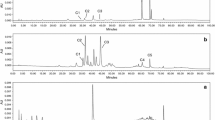Abstract
This study aimed to investigate the metabolism of anthraquinones, including chrysophanol (1), rhein (2), aloe-emodin (3), emodin (4), sennoside A (5) and sennoside B (6), by mixed human fecal bacteria to clarify the relationship between their chemical structural characteristics and intestinal metabolism. Six parent compounds were incubated with mixed human fecal bacteria in vitro to study the metabolic process. A highly sensitive and specific ultra-performance liquid chromatography-quadrupole time-of-flight high-resolution tandem mass spectrometry (UPLC-Q-TOF-HRMS/MS) with MSE technology and MetaboLynx software has been developed to analyze the metabolites of anthraquinones. With this method, a total of ten metabolites were identified, including 1,4,8-trihydroxy-3-hydroxymethylanthraquinone (M1), 2-methylrhein (M2), 7-methylrhein (M3), methyl-esterificated rhein (M4), 1,8-dihydroxy-3-hydroxymethyl-4-methylanthraquinone (M5), physcion (M6), sennidin A (M7), rhein (M8), sennidin B (M9) and rhein (M10), six (M1–M6) of which were first detected on the basis of the exact mass by mixed human fecal bacteria in this work. The metabolism of anthraquinones occurred via hydroxylation, oxidation, methylation, deglycosylation and esterification. In particular, the methyl-esterificated rhein (M4) was first identified as one of the metabolites of rhein, whose metabolic pathway (esterification) is also reported for the first time. The presence of human fecal bacteria played a vital role in the metabolism of anthraquinones and the substitutional groups determined the different metabolic reactions for anthraquinones, which will be useful for the investigation of the study of anthraquinones in vivo.





Similar content being viewed by others
References
Wei SY, Yao WX, Ji WY, Wei JQ, Peng SQ (2013) Food Chem 141:1710–1715
Chen WH, Chen J, Shi YP (2011) J Asian Nat Prog Res 13:1036–1041
Wen XX, Luo KD, Xiao S, Ai N, Wang SF, Fan XH (2016) Biomed Chromatogr 30:1249–1262
Li SW, Yang TC, Lai CC, Huang SH, Liao JM, Wan J, Lin YJ, Lin CW (2014) Eur J Pharmacol 738:125–132
Wang J, Zhao Y, Jin C, Liu D (2011) PLoS One 6:1367–1368
Ko JC, Tsai MS, Kuo YH, Chiu YF, Weng SH, Su YC, Lin YW (2011) Biochem Pharmacol 81:680–690
Yeap S, Akhtar MN, Lim KL, Abu N, Ho WY, Zareen S, Roohani K, Ky H, Tan SW, Lajis N, Alitheen NB (2015) Drug Des Dev Ther 9:983–992
Arvindekar A, More T, Payqhan PV, Laddha K, Ghoshal N (2015) Food Funct 6:932017-8
Xing SH, Wang MY, Peng Y, Dong YQ, Li XB (2015) Nat Med 69:171–177
Zhang W, Jiang S, Qian DW, Shang EX, Duan JA (2014) Chromatographia 77:439–445
Song R, Xu L, Xu FG, Dong HJ, Tian YA, Zhang ZJ (2011) Biomed Chromatogr 25:417–426
Lee JH, Kim JM, Kim C (2003) J Ethnopharmacol 84:5–9
Shia CS, Juang SH, Tsai SY, Chang PH, Kuo SC, Hou YC, Chao PDL (2009) Planta Med 75:1386–1392
Wang DG, Chen LN, Zhu Q, Chen GT, Liu BH (2013) J Chem Soc Pak 35:1168–1173
Dreessen M, Eyssen H, Lemli J (1981) J Pharm Pharmacol 33:679–681
de Witte P, Lemli J (1988) Pharmacology 36(suppl. 1):152–157
de Witte P, Van Hoestenberghe A, Eyssen H (1992) Biopharm Drug Dipos 13:243–253
Harroti M, Kim G, Motoike S, Kobashi K, Namba T (1982) Chem Pharm Bull 30:1338–1346
Lemli J, Lemmens L (1980) Pharmacology 20(suppl. 1):50–57
Hattori M, Kim G, Motoike S, Kobashi K, Namba T (1988) Pharmacology 36(suppl. 1):172–179
Kobashi K, Nishimura T, Kusaka M, Hattori M, Namba T (1980) Planta Med 40:225–236
Meselhy MR, Nishimoto E, Akao T (2001) J Trad Med 18:169–176
Tomotari M (2014) Bioscience of microbiota. Food Health 33:99–116
Savage DC (1977) Annu Rev Microbiol 31:107–133
Wyatt GM, Horn N (1988) J Sci Food Agric 44:281–288
Li M, Zhou HK, Hua WY, Wang BH, Wang SY, Zhao GP, Li LJ, Zhao LP, Pang XY (2009) Syst Appl Microbiol 32:193–200
Plumb RS, Johnson KA, Rainville P, Smith BW, Wilson ID, Castro-Perez JM, Nicholson JK (2006) Rapid Commun Mass Spectrom 20:1989–1994
Yan GL, Sun H, Sun WJ, Zhao L, Meng XC, Wang XJ (2010) J Pharmaceut Biomed 53:421–431
Yang SP, Shi WM, Hu DF, Zhang SX, Zhang HY, Wang ZH, Cheng LL, Sun FF, Shen JZ, Cao XY (2014) J Agric Food Chem 62:9201–9210
Acknowledgments
This work was financially supported by National Science Foundation of China (No. 81274062).
Author information
Authors and Affiliations
Corresponding author
Ethics declarations
Conflict of interest
The authors declare that they have no conflict of interest.
Ethical approval
This article does not contain any studies with human participants or animals performed by any of the authors.
Additional information
M. Fan and C. Peng contributed equally to this work.
Rights and permissions
About this article
Cite this article
Fan, M., Peng, C., Peng, Y. et al. Analysis of Metabolites of Anthraquinones by Human Fecal Bacteria Using UPLC-Q-TOF-HRMS/MS. Chromatographia 79, 1593–1604 (2016). https://doi.org/10.1007/s10337-016-3183-0
Received:
Revised:
Accepted:
Published:
Issue Date:
DOI: https://doi.org/10.1007/s10337-016-3183-0




